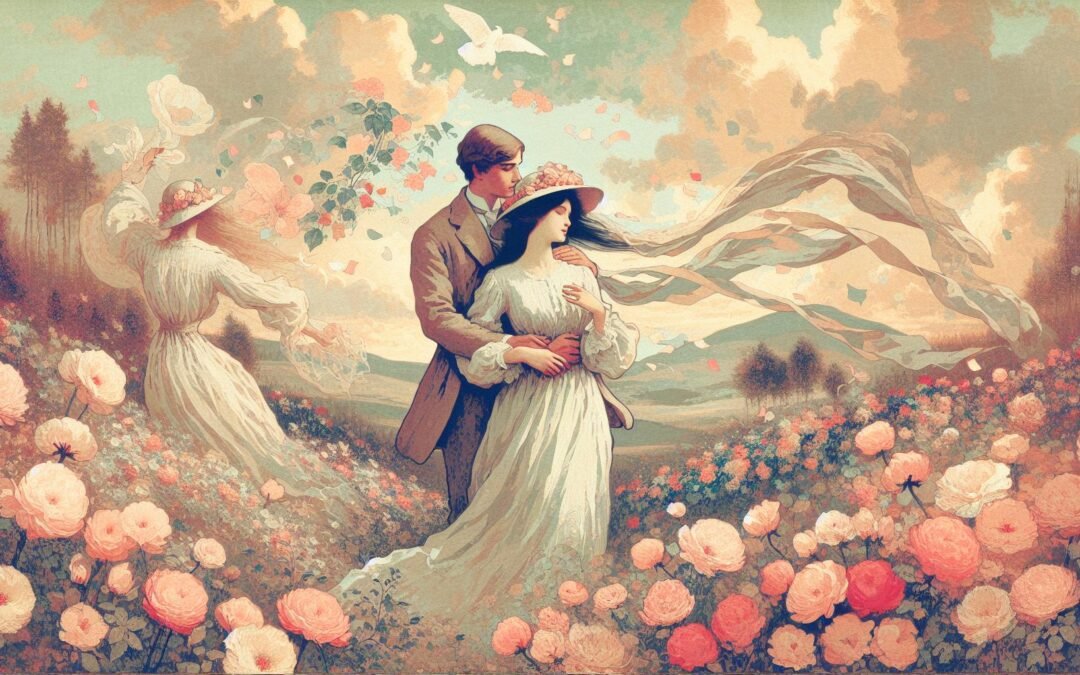Love poetry for hubby weaves longing and daily devotion into cadences that oscillate between ancient impulse and new invention. Through scrolls, manuscripts, digital threads, the genre thrives in an unceasing process of naming, parsing, and remaking the shared life of marriage. The roots push deep: epithalamia from Greek and Roman traditions, Persian ghazals articulating bonds in metaphoric gardens, and medieval nuptial songs, all provide a current of tradition that later poets interpret and disrupt. The study of these transformations reveals ongoing negotiations between partnership as obligation and partnership as possibility. On Romantic Poems, readers uncover glimmering moments of companionship and poetic bravura that keep the form alive no matter its language.
Love Poetry for Hubby Through Eras and Forms
The earliest lyric traces intersect ritual and longing, circling loss, fertility, and invocation. Hymns from Sumer, Egypt, and Greece present marital bonds shaded by supplication, praise, and duty. In the Song of Songs, a bride’s voice flickers among harvest metaphors; her beloved appears in scents, landscapes, and sweet fruit. Classic epithalamia observe the union, entangling hymns to gods with private yearning. Sappho’s fragments, preserved on papyrus, show intimacy spiraling outward but seldom focused cleanly on husbands. Those few directions become notable for their rarity and fusion of the sacred and domestic. Readers tracking these currents can pursue echoes in the works of Chaucer or in medieval troubadour verse, though courtly love eclipses marriage as theme. However, archival nuptial songs reveal rare but clear articulations of wife to husband, devotional and candid at once.
Within the Islamic Golden Age, Persian and Arabic forms such as ghazal and qasida occasionally foreground spousal love using charged imagery—wine, gardens, celestial order. In these, devotion spins between spiritual allegory and lived experience. Later, as the Renaissance reconstructs the self in relation to law and doctrine, English poets encounter spousal love as raw matter for spiritual resolve and mortal affection. Anne Bradstreet writes, “If ever two were one,” compounding scriptural reference with the ache of separation and the heat of shared seasons. The sonnet persists as crucible for address to a beloved, shaping marital passion into the measured pace of argument and turn. John Donne scythes intricate nets of wit, metaphysics, and conjugal admiration.
Modern and Contemporary Transformations
By the Victorian period, poetic roles for wives broaden within ideological constraint. Christina Rossetti envisions mutual kindness as the pulse of a true marriage. Elizabeth Barrett Browning, in the Sonnets from the Portuguese, spells conjugal yearning as blessing and ordeal. Poetic correspondence—letters hidden in trunks, journals left untouched—preserves the quiet solidarity of shared endurance, sometimes needling societal roles through glancing wit or defiant clarity. In the period mapped by Victorian lyrics, marital poetry charts the stylized region between propriety and passion.
The twentieth century awakens a discordant music. Sylvia Plath and Adrienne Rich strip the veneer from marital address, illuminating fault lines of power, anger, and co-dependence. Gender roles collapse or feint: a husband emerges as adversary, companion, spark to reinvention. New poetries erupt as poets interrogate whether marriage constructs or stifles authentic selfhood. This reorganization travels across South Asian, Latinx, and African American cultures where new forms and voices reshape inherited models for hybrid realities. Polyphony now reigns in both anthologies and personal collections.
Digital and Global Innovations
In the digital present, love poetry for hubby surges into forums, zines, meme collections, confessional feeds. Queer poets—Jericho Brown, Eduardo C. Corral, countless others—write contrapuntal lines on partnership, isolation, and erotic mapping. Gendered templates splinter and reform; partnership invents itself moment by moment. Poetic forms wander easily from traditional rhyme to prose poetry, haiku, and visual collage. Instead of fixed “I” and “you,” a chorus of voices braids together shifting identities. The shared poem turns kaleidoscopic, a record of devotion’s alchemy under the pressure of modern contingency.
Themes and Emotional Registers in Love Poetry for Hubby
Companionship, when filtered through a poet’s attention, becomes a radiance in gestures, glances, or repetition of shared customs. This poetry marks the dinner table as altar, the garden gate as boundary where memory and hope trade places. Habits—shoes arranged by the door, shirts folded with unmatched precision—ground lyric flights in pattern and partnership. Rather than abstract declaration, contemporary poets index these acts in what some call the “inventory poem,” making dailiness the true subject of devotion. At Rhyming Love Poetry, the accumulation of detail stands as proof of relation more acutely than any overt proclamation.
Desire and intimacy orbit each other through centuries of writing. In older works, bodies disguise pleasure under layers of metaphor—skin imagined as orchard, lips transformed by similes. With sociocultural shifts comes greater bluntness: the hand slipped across a back, the pulse under shared sheets, the fluorescence of aged skin. Some poets observe how routine gestures gather seismic meaning, recording how years, illness, or absence strain and renew erotic charge. Marital intimacy emerges at once as sacrament and as a refusal to succumb to monotony.
Survival, Conflict, and Renewal
Texts chronicling illness, caregiving, and separation compete with those that revel in union. The ravages of chemotherapy or the chill of hospital corridors test endurance, but also become subject for transformation. Poets reframe scar, silence, or routine as emblems of persistent connection. Separation—whether spatial or emotional—illuminates veiled regrets or galvanizes new forms of longing. Aging enters as both drift and constancy: veins mapped across hands, sound of a partner’s voice softened by decades. Memory itself threads present and past, forcing lyric address to reckon with vanishing and residue.
Conflict enters as proximity exposes fault lines in shared life. Poetry tracks slammed doors, the illogic of silence at dinner, and the tangled calculus of apology and repair. Dramatic monologue becomes laboratory for mapping states between accusation and sympathy. Some compositions focus narrowly on the music of apology, others pivot toward the full arc of reconciliation. Instead of veiling rupture, contemporary poetry dwells on how love reconstructs itself after the storm, elevating forgiveness, honest inventory, and slow honesty.
Domestic contexts supply endless material for invention and affection. Bed-making, pet care, the hidden theater of kitchen politics—all appear as worthy subject. Subtle irony or joking persists, punctuating minor frictions with laughter rather than resentment. Poetic attention transforms these rituals, aligning them with collective practice or mythic resonance. Rather than grand legend, the husband-poem presents the lived epic: the favorite mug, the calendar in code, the half-remembered anniversary. Shared activities—playing board games, observing holidays, watching the sky through the window—become fertile soil for myth-making in microcosm. Further examples can be traced in poems by poets addressing partnership from within struggle or reconciliation.
Lexical and Structural Craft in Hubby-Addressed Love Poetry
The word-hoard for this art crosses archaic, colloquial, and invented language. Remnants of “thou,” “betwixt,” and “lest” appear not through nostalgia but for their precision in ritual or elevated context. Colloquialisms punctuate lines for intimacy—private slang, in-jokes, winks at history. Neologisms arise to capture shifts in partnership, e.g., “husrediscovery,” “co-silliness.” Serious poems inflected by epic or sacred register intermingle with notes of irreverence. Collections like Love Poetry: Rhyming Poems About Life display these movements across vocabulary.
Figurative language animates these works. Marriage may reappear as a voyage, its participants wind-tossed sailors or anchors grounded in home soil. Simile manifests in careful listening—“He listens as a field after rain”—or the circling migration of longing’s return. Metonymy gathers affection into a watched clock, the final tomato of summer, a warmed sweater. Synecdoche focuses passion on the nape of a neck, the familiar laugh in a quiet room. Meanings spiral within double entendre, recursive phrasing, and the architecture of association. At Tennyson’s bardic level, argument and turn become the engine for conjugal address.
Form, Sound, and Allusion
Classic forms persist. Sonnets, with argument and turn, continue to crystallize tension and devotion. Free verse liberates pace and expectation, functioning as improvisational speech. Haiku and micro-poems grant compression: an entire marriage rendered in three lines. Prose poetry borrows from essay, presenting marriage as accumulation and fragment, compressed by lived complexity. Poets with musical attunement employ alliteration, assonance, and consonance. Lines are built for both mouth and ear, shadowing the emotional arc of attachment with crescendos and silence. Such compositional attention appears in voices at Dickinson’s angle and Neruda’s physicality alike.
Intertextuality persists as a living thread. Wife-poets weave references to literary couples, from Penelope and Odysseus to figures in myth, casting their husbands as archetype, foil, or counter-narrative. Allusions connect poems to scriptural or canonical traditions. Researchers may explore reservoir of allusion at Poets.org and through comparative readings at Poetry Foundation.

